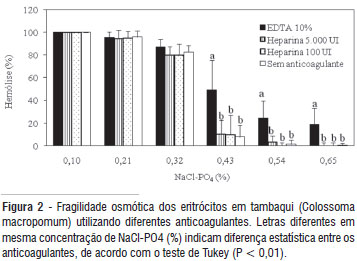The efficacy of sodium heparin and tripotassium EDTA as anticoagulant and their effect on the hematological parameters of tambaqui (Colossoma macropomum) were evaluated in this study. Ten fish weighing 384.9 ± 85.71 g and measuring 27.90 ± 2.10 cm were used for heparin 5.000 IU, heparin 100 IU and K3EDTA 10% evaluation. Clotting inhibition after 10 h, erythrogram and osmotic fragility of erythrocytes were observed. The results were submitted to variance analysis and means compared by Tukey test (P < 0.05). Heparin 5.000 IU, heparin 100 IU and K3EDTA 10% were effective in preventing coagulation for more than 10 h. However, tripotassium EDTA caused hemolysis since first moments. In erythrogram there was no difference (P > 0.05) in erythrocyte count, hematocrit, hemoglobin and MCHC. On the other hand, an increase in MCV (P < 0.05) in samples kept with K3EDTA10% was observed. This anticoagulant provoked a significant increase (P < 0.01) in the osmotic fragility of erythrocytes when compared to pure heparin, diluted heparin and the control group. Heparin as an anticoagulant is more appropriate for tambaqui since it was effective in preventing coagulation for more than 10 h, without causing hemolysis, changes on hematological parameters or osmotic fragility of erythrocytes.
blood clotting; hemolysis; osmotic fragility of erythrocytes; fish hematology



